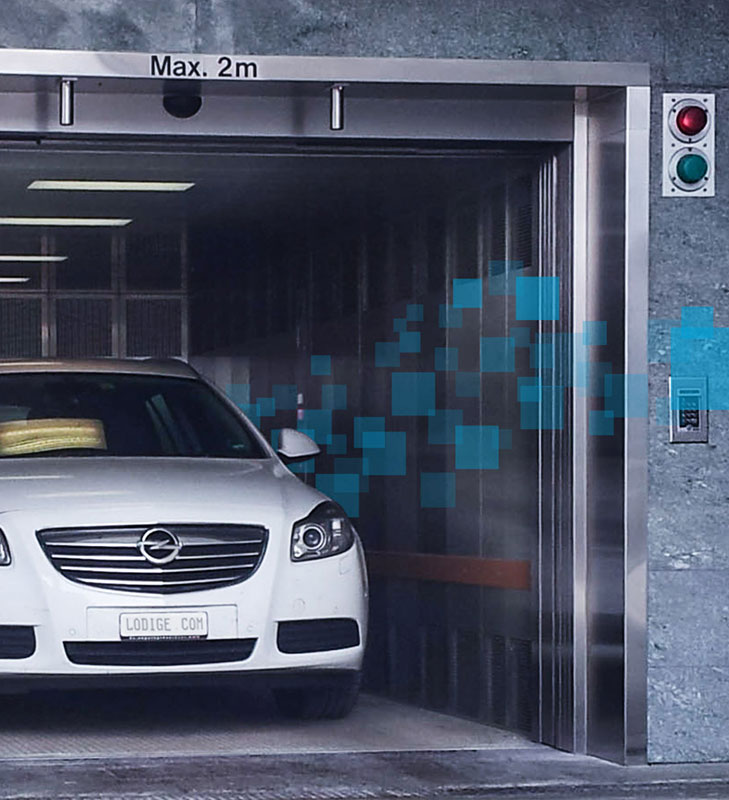A car elevator, also known as a vehicle lift or automotive elevator, is a mechanical system designed to vertically transport vehicles between different levels in buildings such as parking garages, car showrooms, private residences, and commercial complexes. It offers an efficient solution for space-saving parking, especially in areas where land is limited or expensive. Car elevators work similarly to traditional passenger or freight elevators but are built to accommodate the size, weight, and safety requirements of vehicles.
Types of Car Elevators and Their Working Principles
There are several types of car elevators, each with its own working mechanism:
1. Hydraulic Car Elevators
Hydraulic elevators are powered by a piston driven by hydraulic fluid (usually oil). The car is lifted when fluid is pumped into a cylinder beneath or beside the platform, pushing the piston upward.
How it works:
The motor powers a hydraulic pump.
The pump forces hydraulic fluid into the cylinder.
Pressure builds, pushing the piston and platform up.
To lower the car, the fluid is released back into the reservoir.
Best for: Low- to mid-rise buildings (2–6 floors), quieter operation, smooth ride.
Advantages: No need for a deep pit or overhead machine room.
2. Traction Car Elevators
These elevators use steel ropes and counterweights, much like traditional passenger elevators. An electric motor rotates a traction sheave, which moves the ropes and lifts or lowers the platform.
How it works:
The motor turns a sheave (wheel).
Ropes looped over the sheave move the car platform up or down.
A counterweight balances the system for energy efficiency.
Best for: High-rise buildings or where speed and frequent use are required.
Advantages: Faster and more energy-efficient for taller structures.
3. Scissor Lift Car Elevators
Scissor lifts use a crisscrossing metal support system that extends and contracts to raise or lower the car. These are commonly used for short vertical travel distances.
How it works:
An electric or hydraulic system pushes the scissor arms apart.
As the arms extend, the platform rises.
To descend, the arms fold inward.
Best for: Low-rise garages, service centers, private villas.
Advantages: Compact design, cost-effective for short lifts.
Key Components in a Car Elevator System
Car Platform: The flat, reinforced surface on which the vehicle is parked.
Guide Rails: Keep the platform aligned during movement.
Doors/Gates: Automatic or manual doors for safety and enclosure.
Control Panel: Allows users to select floors and operate the system.
Safety Features: Include sensors, overload protection, emergency stop buttons, and anti-slip surfaces.
Operation Process
Entry: The vehicle drives onto the platform and stops within the marked area.
Weight Detection: Sensors ensure the load does not exceed capacity.
Door Closure: Once safely positioned, entrance doors close automatically.
Vertical Movement: The lift mechanism raises or lowers the platform to the selected level.
Exit: At the destination level, doors open, and the driver exits the elevator.
Some modern car elevators also offer remote control, keycard access, or even automated vehicle parking systems, further enhancing convenience and security.
Applications of Car Elevators
High-density urban areas: Maximizes space by stacking cars vertically.
Private homes and villas: Adds secure, space-efficient parking in basements or rooftops.
Automotive dealerships and showrooms: Moves vehicles between floors without ramps.
Commercial buildings and hotels: Provides valet-like automated parking services.
Repair shops and service centers: Used to raise vehicles for maintenance or storage.
Benefits of Car Elevators
Space-saving: Eliminates the need for long ramps or large turning radii.
Time-efficient: Reduces parking time, especially in busy buildings.
Secure: Access-controlled systems reduce theft or damage risk.
Architectural flexibility: Allows designers to create parking in unconventional spaces (underground, rooftop, etc.).
Eco-friendly: Reduces land usage and, in some cases, supports automated parking systems that reduce engine idling time.
A car elevator is a smart, space-efficient solution for moving vehicles vertically in both residential and commercial settings. Depending on the type—hydraulic, traction, or scissor lift—the elevator operates using different mechanical principles but shares the same core purpose: to transport vehicles safely and efficiently between floors. As urban space becomes more limited and modern architecture evolves, car elevators are becoming an increasingly popular and practical choice worldwide.












